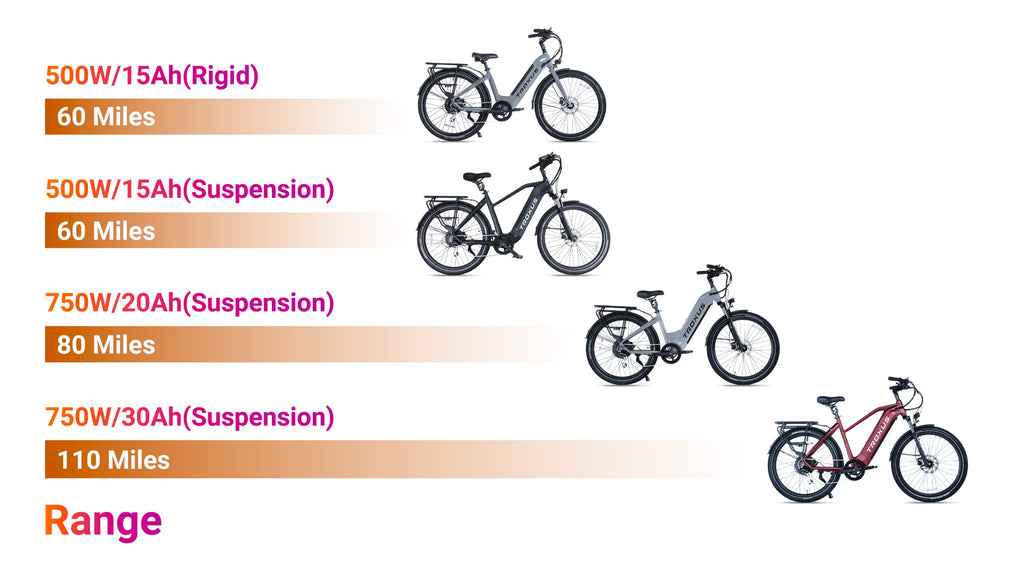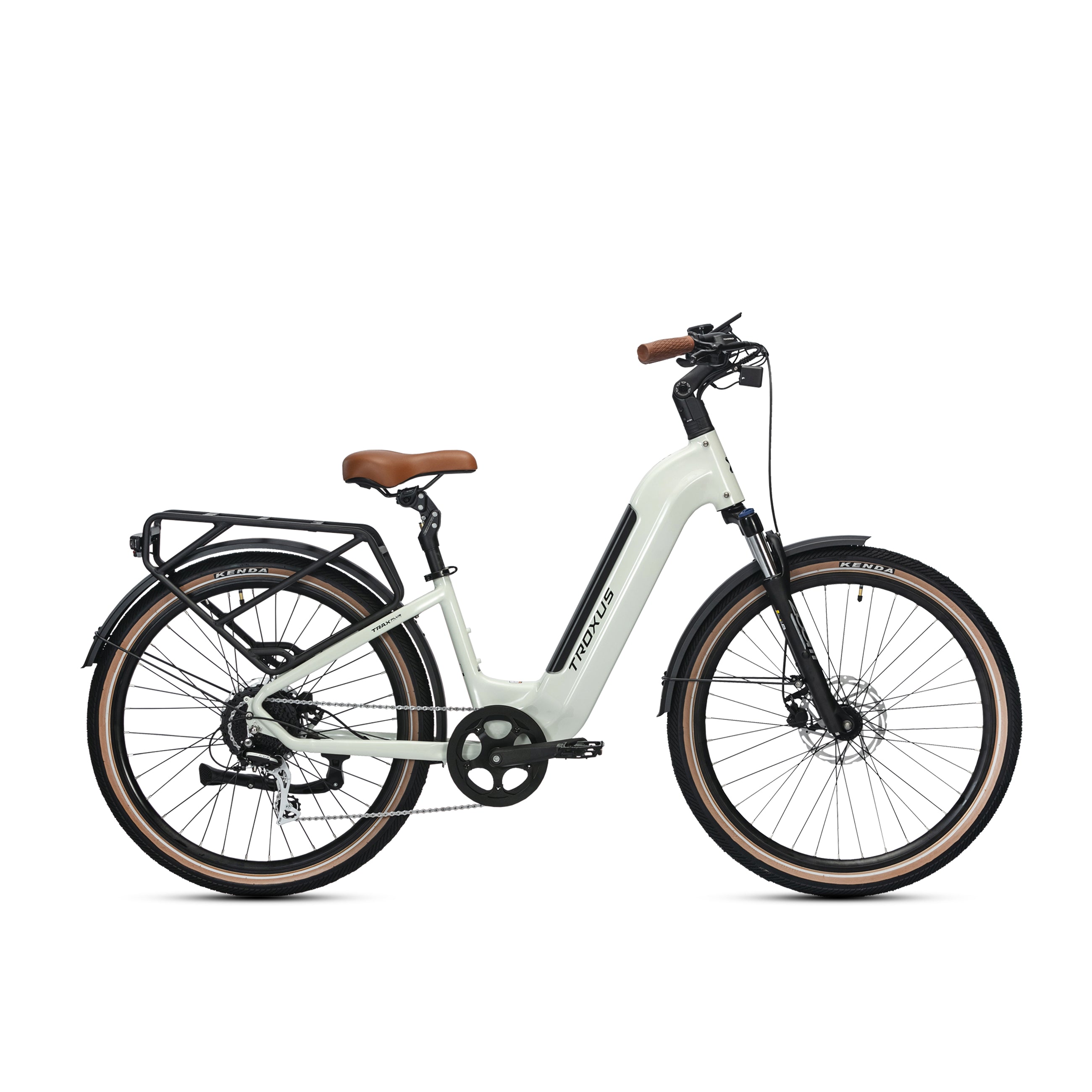The hum of silent propulsion, the wind in your hair, and the invigorating sense of freedom—these are just a few of the reasons why you love your commuter electric bike. However, if there's one finite resource that can put a temporary halt to your rides, it's the battery. In our extensive guide for electric bike enthusiasts, we’ll not just teach you how to make your charge last longer, but also how to enhance your overall riding experience. Whether you're a die-hard urban eco-warrior or a daily city explorer, the strategies we're about to impart could make your next adventure on two wheels your best yet.
Here are the ultimate strategies to keep your battery humming along so you can focus on what really matters—enjoying the ride while knowing you're doing your part for a more sustainable future.
Content
Understanding Your Electric Bike Battery
Environmental Factors and Temperature Management
Monitoring and Utilizing Battery Data
Understanding Your Electric Bike Battery
Before delving into strategies to preserve your electric bike's battery life, it's essential to grasp the intricacies of what powers your commuter electric bike and its operational mechanisms. Understanding the interplay between different components, such as the motor, battery, and energy management system, can provide valuable insights into optimizing performance and prolonging battery longevity. By familiarizing yourself with these aspects, you can make informed decisions to enhance your commuter electric bike riding experience while maximizing the efficiency and lifespan of your battery.
Types of Electric Bike Batteries
Most electric bikes on the market today typically utilize one of three main types of batteries: lithium-ion, lead-acid, or nickel-cadmium. Each battery type has its own set of characteristics, advantages, and limitations, catering to different needs and preferences of electric bike users.
- Lithium-ion (Li-ion):Lithium-ion batteries are the most prevalent battery type used in modern devices due to their exceptional energy density and relatively low self-discharge rate. This superior energy density allows them to store more energy in a compact size, making them highly suitable for a wide range of applications, including portable electronics like smartphones, laptops, and tablets, as well as electric vehicles where efficiency and power are crucial.
- Lead Acid (Pb):These traditional lead-acid batteries, known for their robust cost-effectiveness, are commonly found in older or budget car models and uninterruptible power supply systems. Despite their heavier weight, they remain a popular choice due to their reliable power storage capabilities. The functionality of lead-acid batteries is based on a chemical reaction that includes lead dioxide, lead, and sulfuric acid, ensuring a steady and dependable power source for various applications.
- Nickel Cadmium (NiCd) and Nickel Metal Hydride (NiMH):These battery types, while once prevalent in various applications, have seen a decline in usage over time. This decline can be attributed to their lower energy density compared to the more modern Li-ion batteries, which have become the preferred choice in many industries. NiCd batteries, in particular, have faced criticism for their environmental impact due to the presence of cadmium, prompting a gradual shift towards greener and more sustainable battery options that align with eco-friendly practices and regulations.
How Electric Bike Batteries Work
Your electric bike battery plays a vital role as a repository for electrical power, serving as the powerhouse for your ride. This stored energy undergoes a transformation into mechanical energy that drives your bike forward with remarkable efficiency and speed. Charging the battery sets off a chemical reaction that effectively preserves this energy for your journeys. Each time you pedal, you tap into and utilize this stored energy, gradually depleting it with each adventure. Having a grasp of these essential processes is like unraveling the inner workings of your bike. Looking ahead, let's explore further into specific riding techniques that will not only enhance your riding pleasure but also ensure the enduring strength and vitality of your bike's "heart."
Proper Charging Practices
We all appreciate the convenience and efficiency of charging our devices quickly, but it's important to delve deeper into the intricacies of battery life preservation. Ensuring the longevity of your battery involves understanding optimal charging practices, managing heat generation during charging cycles, and being mindful of factors that can impact overall battery health. By implementing these considerations, you can extend the lifespan of your battery and optimize its performance in the long run.
Follow Manufacturer Recommendations
Every electric bike manufacturer has meticulously tested their machines to understand the best charging practices. Through extensive research, rigorous testing, and detailed analysis, they have dedicated countless hours to ensuring the longevity, reliability, and efficiency of their e-bikes. Ignoring the expert guidance and insights they provide is akin to recklessly disregarding valuable information that could potentially compromise the performance and lifespan of your electric bike. By adhering to their meticulously crafted recommendations, you not only safeguard your investment but also enhance your overall riding experience, ensuring you derive optimal benefits from your electric bike while enjoying a smooth and efficient ride every time.
Troxus E-bikes is really good at making sure their electric bikes are super safe and work really well. They use chargers, batteries, and other stuff that's is equipped with UL certification. When you ride a Troxus electric bike, you're not just using a cool and eco-friendly way to get around, you're also riding knowing that your bike is safe and works great.
Avoid Overcharging and Undercharging
Overcharging, a prevalent issue in the realm of electronic devices, occurs when a battery surpasses its designated capacity during charging. This leads to increased temperatures, gradual reduction in capacity over time, and ultimately shortens the battery's lifespan. Moreover, the chemical reactions within the battery can become unstable, risking potential hazards like leaks or even fire incidents. Conversely, undercharging, though less commonly discussed, can give rise to a concerning phenomenon known as 'deep discharge.' This phenomenon causes irreparable damage to the battery cells by excessively draining them below safe levels, leading to a loss in overall battery health. Striking a delicate balance in the charging process is paramount to guaranteeing the longevity and optimal performance of your valuable devices for prolonged and safe use.
Establish a Charging Routine
Predictability plays a crucial role in maintaining the longevity of your battery. By establishing a consistent routine of regular charging sessions, you not only protect the well-being of your battery but also ensure that your commuter electric bike is always ready for your next thrilling adventure. This proactive approach not only extends the lifespan of your battery but also enhances your overall riding experience by eradicating any concerns about battery readiness. Embracing this mindful strategy nurtures a deeper bond with your e-bike, intensifying the connection between you and your trusted electric companion. This harmonious relationship fosters a sense of reliability and enhances the joy of each ride, making every journey with your electric bike more fulfilling and enjoyable.
Optimal Riding Techniques
Similar to how you adopt a different posture and technique on a standard bike, an electric bike demands a rider's attention to battery-saving tactics.
Maintain a Steady Pace
While we don't expect you to ride in a robotic manner, maintaining a steady pace can greatly enhance your battery efficiency. By avoiding sudden accelerations and frequent stops, you can prevent rapid power drain. Striking a balance in your riding style is crucial for optimizing battery longevity and ensuring a more pleasant overall experience. Remember, a smooth and consistent approach to riding can go a long way in preserving your battery life for longer rides. It's like finding a rhythm that not only conserves energy but also allows you to enjoy the journey without interruptions caused by frequent recharges. Consistency in your riding habits can lead to a more sustainable and enjoyable electric biking experience while extending the range of your rides.
Use Pedal-Assist Wisely
Pedal-assist modes are ingeniously crafted features that have been meticulously designed to elevate your cycling experiences. These modes offer subtle support while ensuring you maintain control and a sense of freedom during your rides. It is crucial to grasp the nuances of when and how to effectively utilize the different levels of pedal-assist. This understanding is key to enriching your cycling journey and broadening the horizons of exploration. By honing your skills in utilizing the diverse pedal-assist modes at your disposal, you can refine your cycling prowess. This mastery will open up thrilling possibilities, allowing you to effortlessly traverse uncharted terrains and unveil new horizons in your cycling adventures.
Understanding 'Range Anxiety'
While it's a frequently utilized phrase in the realm of electric vehicles, the notion of route planning driven by the allocation of battery power is of paramount importance. Delving into the intricacies of the energy demands for every segment of your trip provides you with the ability to strategize with precision, thus reducing the likelihood of encountering unforeseen power shortages while on the move. Embracing this proactive strategy not only guarantees a seamless and dependable travel experience but also significantly enriches the overall journey with enhanced efficiency and peace of mind. By being mindful of optimizing battery usage and planning for charging stops at convenient locations along the route, drivers can ensure a smooth and uninterrupted journey, minimizing any potential range anxiety and maximizing the benefits of electric vehicle technology.
Terrain and Route Planning
You might think a steeper incline translates to heavier battery use, and you'd be right. But there are more subtleties at play when it comes to picking your path.
Route Selection
A direct, flat route is generally known to be the most energy-efficient option, making it ideal for conserving battery power during your ride. On the other hand, choosing scenic paths that include hills and off-road sections presents a more diverse and challenging terrain, requiring additional battery usage. It is crucial to consider these factors when mapping out your route to effectively manage energy consumption and ensure a smoother overall journey. By taking into account these subtle intricacies, you can make well-informed decisions that enrich your electric riding experience and contribute to an enjoyable and sustainable commute.
Efficient Riding Habits
Beyond just planning, adopting efficient riding habits according to the terrain can make a significant difference. For instance, when leaning into turns, riders can distribute their weight effectively, allowing for smoother cornering and enhancing control. Anticipating stops not only conserves energy by reducing the need for sudden braking but also promotes a safer and more fluid riding experience. Furthermore, standing on the pedals over small hills engages different muscle groups, providing both a physical challenge and a change in riding posture that can benefit overall comfort and performance. Riders can also consider adjusting their gear ratios based on the terrain to optimize pedaling efficiency and power output. Additionally, maintaining a relaxed grip on the handlebars while riding can reduce arm fatigue and improve handling on bumpy surfaces. By incorporating these detailed strategies into their riding routine, cyclists can enhance their overall riding experience and performance.
Pack Efficiently
When preparing for your ride, it's crucial to take a moment to pause and carefully reflect on the essentials you truly need. Remember, carrying extra weight will require increased power from your battery. Opt to pack only the items that are absolutely necessary, and consider planning out where to place any additional accessories thoughtfully. If you ever feel unsure or need guidance in this decision-making process, rest assured that our range includes a diverse selection of high-quality accessories to help you make well-informed choices. Remember, the right gear can enhance your overall riding experience and ensure you're fully equipped for any adventure that comes your way.

Proper Maintenance and Care
Maintaining your commuter electric bike is akin to taking care of a car. Just like neglecting your car can result in various issues, overlooking the maintenance of your electric bike can lead to similar problems. Among the crucial components to keep an eye on is the battery, as proper care and attention to it can significantly impact the overall performance and longevity of your commuter electric bike.
According to eBikes.org, a helpful guideline is to schedule bike servicing every six months or after every 1,000 miles of riding. However, this rule is a rough estimate, and the ideal servicing frequency depends on your riding frequency and intensity. A standard tune-up at a reputable bike service shop typically covers adjustments for derailleurs, chain, hubs, wheels, rims, tires, and, crucially, brakes. While most service providers offer an "overhaul" option at a slightly higher cost, which involves replacing worn or damaged components, it remains a reasonable investment in maintaining your bike's performance. If it's been a while since your last service, it's wise to schedule one soon.
Regular Inspections
A thorough inspection of your bike before setting out on your journey is essential to uncover any potential issues before they grow into major problems. Take time to carefully check for any debris buildup around the battery or motor, as this can result in overheating, affecting not only the longevity of your battery but also your bike's performance as a whole. By taking proactive steps to address these minor details, you can guarantee a more seamless and secure riding experience. Remember, a little attention now can save you from bigger headaches later on.
Cleaning Your Bike
Using a damp cloth, gently wipe down your bike to remove dust and grime, paying attention to cleaning all parts thoroughly. Avoid direct water contact with the battery to prevent damage. This cleaning routine not only aids in early issue identification but also safeguards your battery from potential fluid leaks that could affect its performance. By incorporating regular maintenance like this into your routine, you can effectively extend your bike's lifespan and ensure optimal performance for extended periods.
Stowing Your Bike
When your commuter electric bike is not in use, it's highly beneficial to store it in a cool, dry place that is shielded from direct sunlight. By ensuring the storage area is free from extreme temperature fluctuations and humidity, you're actively contributing to preserving the overall condition of your e-bike. This thoughtful approach not only safeguards your bike but also plays a crucial role in extending the lifespan of its battery. This simple yet effective practice can significantly impact the long-term performance and efficiency of your commuter electric bike, ensuring that it remains in top-notch condition for years to come. Your meticulous attention to the storage conditions will be warmly received by all the intricate components of your bike, enhancing its durability and functionality in the long run.
Environmental Factors and Temperature Management
The weather can be an unpredictable beast, with sudden changes that catch us off guard. However, by staying informed about forecasts and having essentials like umbrellas or jackets handy, you can be better equipped to handle whatever Mother Nature throws your way.
Temperature and Battery
Extreme temperatures, whether reaching scorching highs or plummeting to freezing lows, play a crucial role in influencing the chemical reactions pivotal to your battery's functionality. When subjected to such extreme conditions, your battery may endure heightened stress and strain, leading to a potential reduction in its lifespan. Thus, minimizing your battery's exposure to these harsh temperature fluctuations emerges as a proactive measure that can significantly benefit its overall health and longevity in the long run.
How to Ride in the Heat and Cold
While it would be ideal to always ride in a comfortable 70 degrees, that's not always practical. When the weather is hot and sunny, it's a good idea to ride during the cooler parts of the day, like early morning or late evening, to avoid overheating. On colder days, consider insulating your battery with a cover or even removing it from your bike and bringing it indoors to keep it at an optimal operating temperature, which can help maintain its performance in chilly conditions. Additionally, wearing appropriate layers of clothing can help regulate your body temperature and ensure a comfortable ride in varying weather conditions. Remember to stay hydrated and take breaks when needed to enjoy your ride to the fullest.
What About Rain?
Modern commuter electric bike components, with their advanced designs, are engineered to withstand a wide range of conditions, showcasing remarkable resilience and durability. Despite their robust build, these components face challenges when exposed to environmental factors. For instance, in rainy weather, it becomes crucial to shield the e-bike's battery from moisture. The presence of water can accelerate corrosion within the battery, potentially leading to decreased performance and reduced longevity. Thus, it is vital to take measures to keep the battery dry during wet conditions. By ensuring the battery remains protected, you not only maintain optimal functionality but also extend the overall lifespan of your commuter electric bike.
Monitoring and Utilizing Battery Data
The system of your commuter electric bike is like a treasure trove filled with valuable information waiting to be discovered. By tapping into this wealth of data, you can uncover insights that will not only enhance your riding experience but also prolong the battery life of your electric bike.
Usage Metrics and Analysis
By delving into the data that your electric bike offers, you can refine your riding techniques and optimize your experience. Are you perhaps relying on pedal-assist too frequently, causing a strain on battery life? Maybe there's a specific uphill segment during your commute that drains the battery faster than expected. Paying attention to these nuances can lead to a more efficient and enjoyable ride. Remember, the insights from data analysis can be a game-changer for your electric bike journeys. Below is the average range data for Trax commuter electric bikes:

Adjust Riding Habits
The power is within your reach to make well-informed adjustments to your riding style. By gradually implementing small shifts over time, such as focusing on your posture and adjusting your acceleration patterns, you can witness notable enhancements in both battery health and overall riding range. Remember, consistency in these adjustments is key. Engage in regular maintenance checks, pay attention to your riding habits, and ensure you are using the most suitable gear for your needs. These foundational steps will not only optimize your riding experience but also contribute to the longevity and performance of your electric ride.
If changing how you ride feels overwhelming, ask for help. Local bike stores have lots of knowledge and skills to help you improve your cycling. They can give you advice and tips that fit your needs, so you get the most from your electric bike. Learning to pedal efficiently or use pedal-assist better with their help is really valuable. Remember, improving how you ride not only makes your experience better but also helps your electric bike last longer.
Making Informed Decisions
With every bit of data comes a new opportunity. Maybe it's time to consider a different route, or perhaps that's a habit you didn't even realize you had that's quickly draining your battery. The more you learn, the better rider you become.
End of the road? Not for your battery. With these strategies, it's just the beginning.
We hope that this in-depth look at extending your commuter electric bike battery life has provided you with the tools and know-how to make the most out of your city travels. Remember, the small changes can add up to significant improvements, not just for your bike but for the environment and your wallet as well. With a heart charged and ready for adventure, where will you take your electric companion next? Your ride, your rules—sustainably powered every inch of the way.








